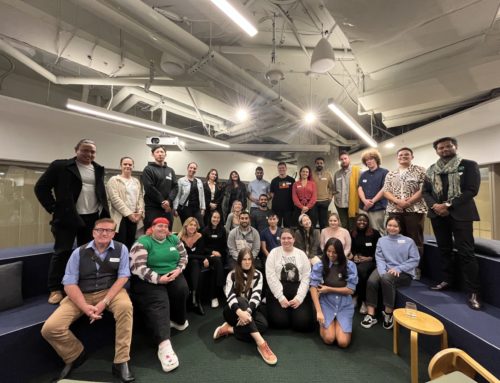Key Takeaways:
– Social community management combines the responsibilities of sales, customer service, PR and even tech teams into one role
– Setting them up for success helps you get the most out of your social media presence, by inviting your customers to build a personal relationship with your brand
– Clearly defined roles for your community managers enables them to do what they do best – foster and grow your community in line with your brand’s mission
I’ve worked community management for my entire social media career. This has ranged from monitoring comments on the pages of major news networks, to swapping love of films and food items to offering customer service on parenting goods and electronics. And it’s one of the parts of social I often hate: reading the spam, hatred and absolute disrespect that comes from people online because they forget someone is on the other side of reading it every day, it will make even the most optimistic person lose a little faith in humanity.
But that does not detract from the fact that it is also one of the most important part of social for a business. To be that close to the customer, to be on the pulse of their sentiment about your product – it can help shape your communication in real time – something not offered by traditional forms of advertising.
Without stringent community management strategies, your business can be missing out on what social really has to offer- that two-way relationship with your customer.
But moreover, it’s community managers who currently hold the responsibility of making the social discussions better. AI employed by Facebook to filter out hate speech or profanity only go so far, with many typos, nuances and even sarcasm going unnoticed. Facebook still rely largely on users to report comments – or at the very least the community managers to do so.
Without a community management strategy, your business can be missing out on what social really has to offer – a two-way relationship with your customer, in real time.
Look – we’ll caveat that platforms – especially Facebook – have taken an unprecedented move against hate speech with the recent banning of Trump’s account. But that won’t be enough.
So let’s delve into community management – what it is, why we do it and how to do it well.
What is a community manager?
A community manager is a professional community builder who is in charge of maintaining the relationship between brand and community and within the community itself.
Their role most often includes:
_ responding to customer service enquiries
_ deescalating crises and coordinating with PR and business stakeholders to address attacks on the brand
_ monitoring comments to ensure they comply with community guidelines (these usually exclude profanities, hate speech, misinformation and personal attacks)
_ fostering customer relations by engaging with customers
_ responding to press enquiries, identifying opportunities for collaboration or ambassadorship, managing online competitions and much more.
These responsibilities used to be divvied up amongst customer service teams, PR reps, sales teams – but with social, often fall upon the community manager who is more often than not a junior level social media professional who is consulting robust FAQ documents, google and also these internal stakeholders to address your concerns.
Why we need community managers?
Increasingly, the first point of call when a customer has an issue with a business is their social media pages.
_ 67% of consumers have engaged with a brand on social media for the purpose of customer service
_ 83% believe they should get a response within 24 hours or less
_ The Facebook algorithm rewards meaningful engagements with the customers and results in increased organic reach.
_ Answering a customer’s question on social media prompts 49% of consumers to purchase with 17% of them even willing to pay more when they’ve had a good customer service experience.
But if we’re honest, we didn’t even need to throw all these stats at you to prove that customer is king. Customer service has long been the tenant that will get you more tips, leave customers happy and returning – whether that’s online or off. And so it should be a no-brainer that someone is available to check these comments daily.
Add on a propensity for hate or anger to escalate on social media, and you understand why community management needs to be that bit more robust. Particularly in the name of hate speech, this conversation has become all the more important.
Each platform has its own set of community standards already that usually protects you from illegal things such as defamation and sedition. But even Facebook understand that there is a difficulty in drawing the line in the sand with just that. In their own community standards:
“We are an open platform for ideas, a place for self-expression, connecting and sharing. At the same time, when people come to Facebook, we want them to feel welcome and safe. Content that attacks people on the basis of their protected characteristics has the potential to intimidate, exclude or silence others and isn’t allowed on Facebook. We work hard to keep hate speech and other harmful content off our services.”
Sounding a little vague? Still a little dissatisfied with facebook and other platform’s refusal to step in any earlier? Well in their rather limited defence, words and their meanings are hard to categorically define as good and bad – especially by machines. So that’s where community managers come in.
I spent many a night reading through comments, wondering if they were racist enough to merely hide, delete or altogether ban users from the platforms. I had to examine my own prejudices and what constituted as just a disagreement of their views or a true violation of the policies. And that’s why community managers need to be vigilant.
How to community manage well?
A good community management strategy understands the role of community within their business and how best to foster and grow it. It must remember that these interactions are still essentially 1:1, but just on a larger scale.
1. Define the role of your community
In the same way that you define a social media strategy for your business, how you are showing up on social through your content should also dictate the level of interaction or familiarity you have with them in the comments.
Say you’re a small business, fronted by the founder and want to take them through the whole production process through your content, your community management should back up the same tone of voice and vulnerability, commenting back freely and engaging with the community. Perhaps, that even opens up avenues like private Facebook groups that can build that closeness.
2. Set the values of your community
Adding more stringent protocols around how a community can interact with you and your brand are important for setting the tone of who they are.
Is profanity ok? How far is too far – what constitutes a hide, a delete, a platform ban? Will you have a three-strikes-you’re out process for repeat offenders? How do you draw the line between free speech and protecting people from hatred?
Having your values clear and aligned with your brand mission will give your community managers the agency to address the moments where they aren’t met by hiding or blocking users in violation. The line may never be clear around what we allow in the name of free speech and that we have to remove so we can move our society forward in tolerance, but starting from a value-based space will help to make those moralistic decisions.
3. Establish clear processes for the community managers
What comments are responded to and what will just be left? Who does the community manager contact if they need more information or there is a problem? How often are they checking – are there service hours to adhere to?
These processes should factor what is realistic for your particular business – whether that means that privacy policies restrict any further customer service enquiries to only be discussed off the platforms or they can easily be managed through an automated FAQ service like a chatbot.
4. Check in with your community managers
As those closest to your community, your community managers have a great insight into what customers are talking about. Whether that’s the sentiment around your product or a new trend that would make for some good content or even a business upgrade, you only have to open your ears and eyes to what your customer is talking about on social to make decisions that they will love. Don’t overlook what your community manager can offer your business.
Want to get started with community management in your business? That’s where The Social Story can help. We help you build a robust strategy that is tailor-made to your brand’s mission and needs. Book a consultation to see where a well-managed community can do for you.
Photo by Vonecia Carswell on Unsplash





